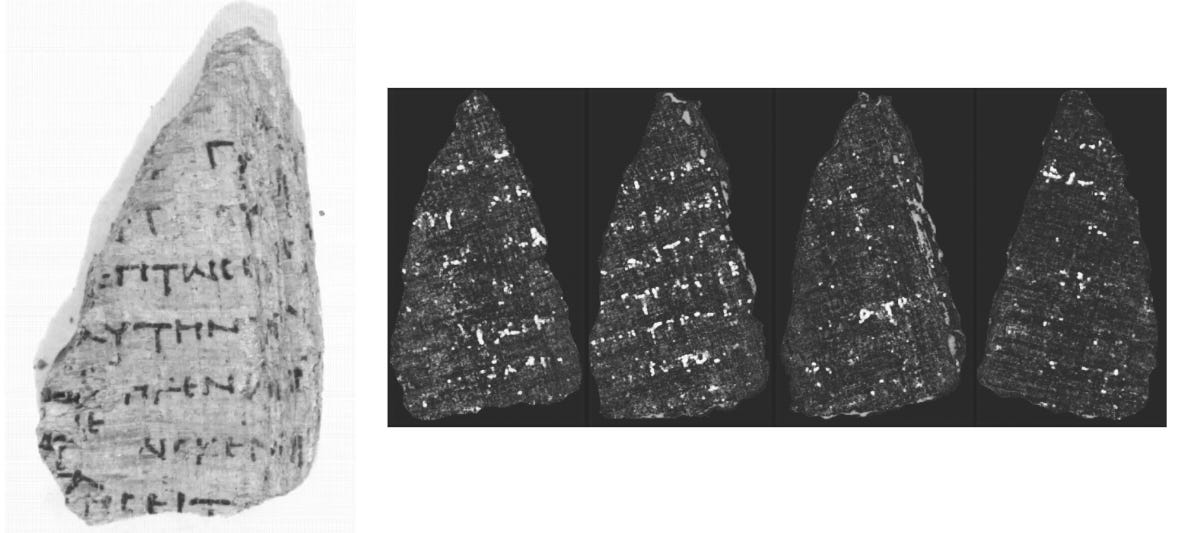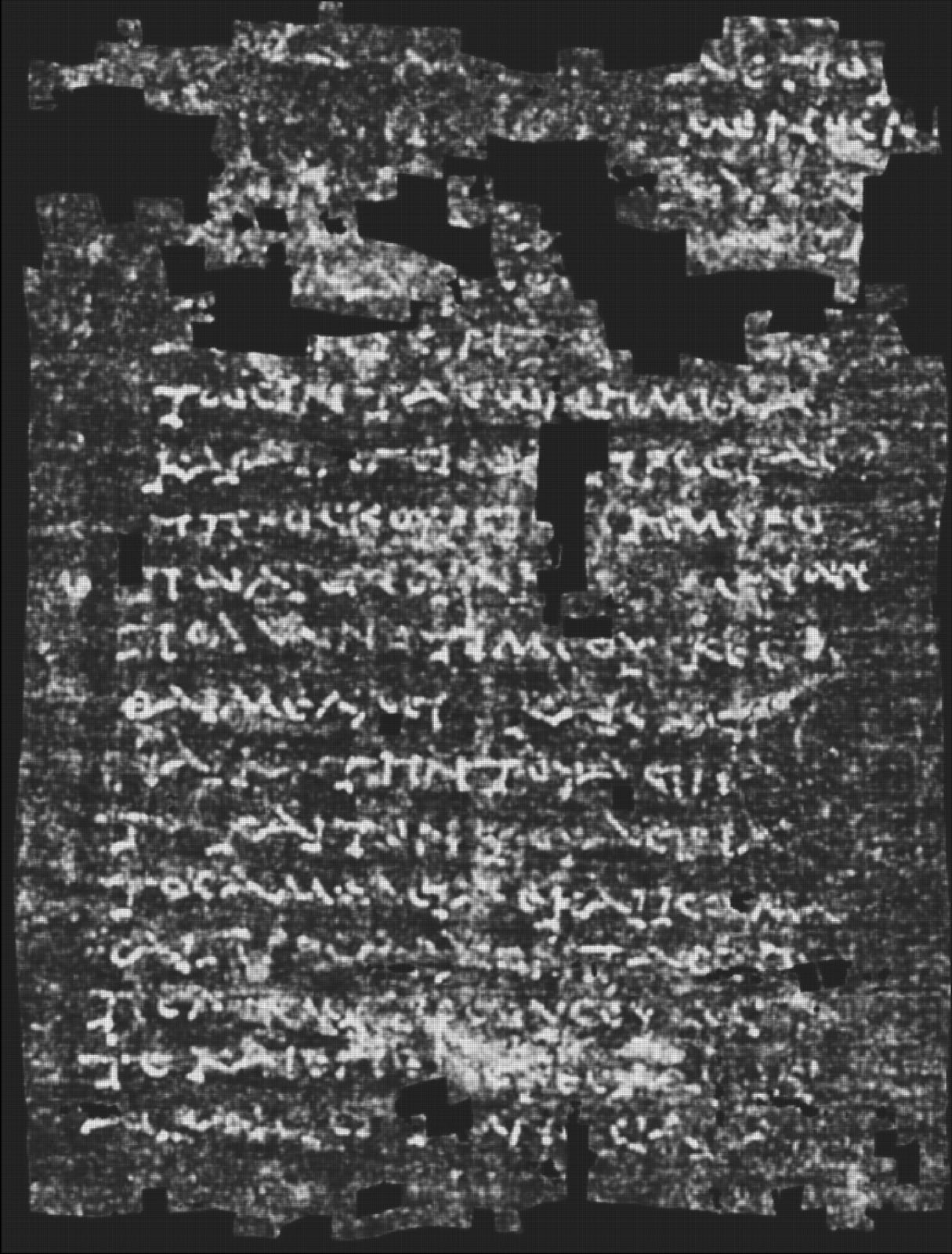Column of text from PHerc. 172 (Scroll 5)
These scrolls are full of text! Help us extract it, win prizes and change history forever!
A recurring question concerns the limited release of additional text from Scroll 1 (PHerc. Paris 4) or Scroll 5 (PHerc. 172). The objective is not to isolate excerpts from one or two items, but to establish a pipeline capable of reading the collection as a whole.
Over recent months the project advanced four interconnected components: scroll-holder case design, X-ray tomography, (semi-)automated unwrapping, and ink detection. Much of this work is not immediately visible outside the project, yet it has increased practical capability. To evaluate these improvements in an end-to-end setting, the (semi-)automated unwrapping software VC3D was applied to PHerc. 172 with the aim of recovering a coherent paragraph.
According to the Vesuvius Challenge papyrological team, the passage addressed below concerns rumor-mongering in certain public venues and the busybodiness of those who instigate legal conflicts. Within that context, Epicurean ethics is critical of such behavior and instead promotes lathe biosas—living quietly and avoiding public entanglements.
Extracted the last column before the title
We are able to read the upper part of the final column of the text, located just before the recently discovered end title. Our team of papyrologists has been working around the clock to produce a preliminary transcription. Some time ago, members of our papyrology team annotated some faint traces visible in this portion of the scroll. Even then, two everyday words immediately caught the eye: κουρεῖον (barbershop) and μυροπώλιον (perfume shop), identified for the first time by Maria Chiara Robustelli. More recently, the team turned to the newly-extracted column and managed to read and discuss more lines of text. In this joint effort, both the current and former papyrological adjudicators worked together, picking out key words like μεθύϲκεϲθαι (to get drunk, read by Daniel Delattre). This careful work led to Federica Nicolardi's exciting identification of a quotation from the Characters of Theophrastus – specifically, the last part of the description of the moral type of the βδέλυροϲ, the repulsive man (XI).
"δε̣ι̣κ̣ν̣ύει̣ν τ̣ο̣ῖ̣ϲ̣ ἀ̣π̣α̣ν̣-
τῶϲιν τὰ ἐ̣ωνημέ̣να
καὶ̣ δ̣ι̣η̣γεῖϲ̣θαι̣ προϲτὰϲ
ἢ πρὸϲ κουρε̣ῖ̣ο̣ν̣ ἢ μυρο-
5 πώλι̣ο̣ν ϲυνκαθ̣η̣μ̣ένων
πολλῶν ὅτι μεθύϲκεϲ-
θαι μέλλε̣ι̣.” vac. καὶ ἐ̣κ̣φῆ̣-
ν̣αι καὶ̣ τὴν τοῦ δείν̣α̣-
τοϲ καὶ τὸν τ̣οῦ̣ δείνα-
10 τοϲ· ἀμέλ̣ει̣ δὲ καὶ καλέ̣-
ϲαι πρ̣ὸ̣ϲ̣ ἄρχοντα ϲυμ-
πολί̣τα̣ϲ̣ (…)
“... and (he is apt) to show the goods he has bought to people who run into him. And to go and stand by the barber’s shop or the perfumer’s and explain that he intends to get drunk.” And to expose both the daughter of so-and-so and the son of so-and-so; and no doubt to call fellow-citizens before an archon (chief magistrate) …
Interestingly, the text does not match exactly with the transmitted version of the Characters. For example, it contains the phrase ϲυνκαθ̣η̣μ̣ένων πολλῶν, proposed in the discussion by Claudio Vergara. It also includes extra lines (7–12 and likely more) that appear to continue the description of this moral type, but are not part of Theophrastus’ passage as we know it.
Notes on status and caution
The discussion above reveals how difficult and iterative deciphering these ancient Greek texts can be and, above all, how crucial the teamwork of papyrological experts is to any sort of coherent reading. However, all readings above are preliminary and subject to refinement as additional layers are unwrapped and cross-checked. We are reporting them here to document the state of the pipeline and to show how incremental technical gains translate into papyrological pay-off. This material is not yet to be considered released for academic transcription and publication.
Technical announcements
Models detect ink in the hidden layers of fragments
Recently, we have shown how ink detection models started detecting the ink signal on the exposed surface of fragments PHerc. 500P2 and PHerc. 343P.
During the past weeks, the Vesuvius Challenge team has digitally unwrapped some hidden layers of PHerc. 500P2. The ink detection models highlight visible letters that have been hidden for millennia.

Will training extensively on these fragments provide the missing piece we need to read the collection?
VC3D rebased to the Villa monorepo
The fork of Volume Cartographer containing the surface tracer (VC3D) has been rebased into our Villa GitHub monorepository.
New location: github.com/ScrollPrize/villa/tree/main/volume-cartographerPlease continue contributing by opening Pull Requests directly against the Villa monorepo, and complete your submission here.
August progress prizes
No progress prizes were awarded in August. We keep our standards very high, and there were no community contributions that the team—or other members—are currently using to push us closer to the goal of reading the collection.
We encourage everyone with a passion for antiquity to stay engaged and keep helping. Interesting news is coming in the weeks ahead… 👀



Incredibly exciting! I await more scroll news with bated breath!
Congratulations! And thank so much for the precious work the team does for us all!